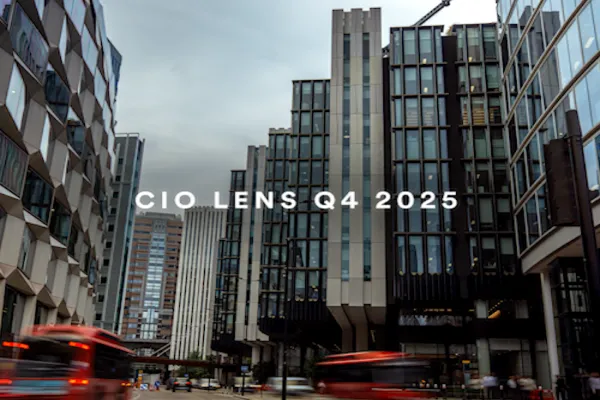
Special Report
If there’s an official playbook for investment strategists, Rob Almeida doesn’t follow it. He doesn’t have a model and he doesn’t convene meetings to discuss whether it’s a good time to shift to growth or value. In fact, Almeida, who is a Global Investment Strategist and Portfolio Manager, MFS Investment Management, eschews standard investment jargon in describing his work.
“I’m an aggregator of where we see risks and opportunities,” he says. “Investing is really simple but incredibly hard. It’s all about simple fundamentals that drive margins and asset prices. The hard part is getting all three of those things right. I’m always trying to bring the conversation back to what the margins and profits will be.”
During the early days in his current role, a colleague of Almeida’s encouraged him to “keep it smart.” Part of what that means to Almeida is sharing what he believes to be authentic and honest.
“I think investors deserve the honest view, and that’s what we try to give them,” he says.
When he’s thinking about margins these days, he’s more likely than not to think about ESG, too.
“The industry misunderstands ESG – it gets confused with altruism and other things. From an investing and company performance standpoint, however, the things you can’t model in a spreadsheet or otherwise predict are often E-, S-, or G-related,” Almeida says.

What does that mean in terms of margins and profits? Transparency and compliance in an ESG-focused world isn’t cheap. “Every company has to be careful about whether its recycling plastic or recycling water, what its workforce looks like,” says Almeida. “There are significant costs associated with practicing ESG, and that all comes back to investing. Is the business sustainable? Is the margin sustainable? Or was it only sustainable because you are doing something you aren’t supposed to do?”
Ultimately, Almeida believes the pursuit of ESG will expose companies with a terminal value problem.
“If a business gets away with unsustainable practices because to date there hasn’t been a light turned upon it, that will be a problem at some point,” says Almeida. “And if there’s one thing Wall Street doesn’t like it’s negative surprises. Left unchanged, those unsustainable practices lead to course corrections and lower margins.”
Here are three ways Almeida and his colleagues at MFS have been “keeping it smart” for investors so far in very challenging 2022.
Excessive analysis can lead to the wrong path
Trying to predict what asset prices will be often leads to mental gymnastics over a host of market signals – including the slope of various yield curves, multidecade-high inflation, and rising labor costs – to figure out which way markets are headed.Economies and markets are complex, adaptive systems in which the behavior of some changes because of the actions of others. When previously distinct viewpoints converge and herding occurs, signals usually become distorted – and overanalysis rules the day.
However, “all financial assets, whether public or private, equity or debt, ultimately derive their value from cash flows,” says Almeida. “Focusing on margins and cash flows can help bring clarity to decision making.”
Using profit margins as a proxy for cash flows, the illustration below shows U.S. and non-U.S. margins over the past 20 years.
“You can see in the data [above] that in 2018, during the cycle that followed the global financial crisis, margins reached all-time highs despite the weakest economic recovery in over a century. That’s because companies got creative in not only protecting margins but also in pushing them to new heights by stretching supply chains, restraining labor costs, and financializing balance sheets,” says Almeida.
Actions such as Almeida mentions were meant to be profit-generating placeholders for businesses until growth normalized. But growth remained slow, and margins began to wane.
Then came 2020. Margins contracted following the early lockdowns, but what looked like a probable decline to the recession-like margin levels of 2002 and 2009 was quickly offset by unheard of levels of monetary and fiscal stimulus. Policymakers undertook a historic transfer of wealth from the public sector to households that sparked a sugar high of double-digit economic and corporate revenue growth. Against what were then falling costs, margins reaccelerated to new all-time highs, where they remain today.
The straight scoop
“Irrespective of what signals the economy or segments of the market may be sending, with financial conditions tightening and growth slowing, companies face too many cyclical and secular pressure points to maintain record margins,” says Almeida.While a return to pre-Covid growth and structurally lower cash flows will create a less favorable market environment than many are used to “that that only matters for those who own the market,” says Almeida.
For example, during the late 1970s, when equity market returns were flat or negative, there were plenty of companies that navigated high inflation and took advantage of the struggle of others to create value for shareholders. At that time, the dispersion of return between above- and below-average companies was stark.
“At MFS we don’t buy the market,” says Almeida. “While we think there could be immense pain ahead for the owners of bad assets and mediocre returns for the average, our objective isn’t to own the average. We take equity stakes in companies that we believe can compound value over a period of many years and we lend money to enterprises and institutions with sustainable growth prospects who we believe can pay our clients back. To us, that means funding organizations that we believe will be around – and successful – for many years.”
“Risk assets are off to a historically poor start in 2022, a year in which seemingly diversified portfolios have been generating undiversified returns,” says Almeida. “Stocks and government bonds are down by double digits, with equities posting their worst performance in decades while investment-grade corporate bonds have had their worst year-to-date performance ever. There have been few places for investors to hide.”
The scenario Almeida describes brings to his mind a Greek fable from long ago: A hawk captures a nightingale. The captured bird tries to convince the hawk that there is better tasting prey in the bush behind it. The hawk replies that a meal already caught, even if small, is better than a larger meal yet to be obtained.
“Over time, the story got boiled down to a bird in the hand is worth two in the bush,” says Almeida. “The idea that what you have is of greater value than what you hope to have is an apt metaphor for valuing risky financial assets in a turbulent 2022 and beyond.”
The metaphor in 2020 and 2021
In Almeida’s view, the nightingale represents yield on cash, things like savings accounts and money market funds. During the worst of the Covid crisis, as interest rates went to zero (or below) in both nominal and real terms, the value of the bird in the hand (cash) evaporated.The hawk is a stand-in for investors. As the yield on safe assets disappeared, the only selling point of riskless assets was that they were a store of value that would return your principal at a future date. That’s not a very compelling proposition.
The two birds in the bush are proxies for risk assets, from corporate bonds to private and public equities to real estate to cryptocurrencies and everything in between. As investors were forced to hunt in the bush for their metaphorical dinner, demand overwhelmed supply – and 2021 net flows into global equities exceeded the combined flows of the prior 20 years.
2022 reversal
In late 2021, investors realized inflation wasn’t transitory and had risen much more than expected. The riskiest segments of the equity market, such as IPOs, SPACs, and small caps began to underperform. With the anticipated yield on cash continuing to rise as the new year began, its effects became more far reaching as a supply of new, competing investments had to be digested.“The bird in hand offered something it hadn’t in a long time: yield. That resulted in the correlation between stocks and bonds going straight up as both asset classes underperformed,” says Almeida.
Consistent with historical patterns, defensive equities outperformed non-commodity cyclicals and growth stocks during this time. Historically, investors have tended to shift from higher-reward but high-degree-of-difficulty assets (e.g., unprofitable enterprises with arcane business models) to lower-reward but lower-degree-of-difficulty ones (e.g., companies with demonstrable, sustainable profits).
“Sticking with the fable, the hard-to-catch – but awfully tasty – bird in the bush becomes less attractive,” says Almeida. “Investors opt for easier-to-catch birds, which are generally enterprises with greater long-term profit certainty. At MFS, we generally prefer these and call them lower-degree-of-difficulty stocks. Others call them quality, a label we use as well.”
Developing a road map
A sharp rise in interest rates has seen the tide turn and now the bird in the hand has value and will compete for investor capital.Higher short-term interest rates may bring higher asset class correlations. Not only might stocks and bonds become more correlated, but styles such as growth and value may sync more closely than in the past. If so, the performance gap between asset classes should prove less pronounced than in recent years.
“We believe emphasis should be placed on the quality of assets owned within each category rather than on the category itself. Security selection will therefore be paramount. The visibility and surety of the cash flow of the individual growth or value stock or high-grade or high-yield bonds is what will matter, not the broad asset class it’s assigned to,” says Almeida.
“Company fundamentals, whether we’re investing in stocks or bonds, will be the main drivers of investors’ returns,” he continues. “In my view, owning quality, cash-flow-generating assets, regardless of style or category, is the portfolio construction roadmap to follow.”
In the early days of the Covid pandemic policymakers in developed markets used every tool at their disposal and often created new ones to counteract the negative economic consequences of temporarily shutting down the global economy in the name of public health. Now the bill for that has come due and policymakers are suffering from sticker shock. But should they be surprised that inflation has zoomed to a four-decade high?
To be sure, some of the inflationary fallout is not their fault. Supply chain snafus, rising labor costs (1,000 years of history shows that labor force participation slumps following every pandemic) and Russia’s invasion of Ukraine are factors beyond the control of central bankers, legislators, and national leaders.
Even in that context, however, “much of the inflation we’re experiencing is the price we pay –after an 11-year post-global financial crisis period of growing imbalances – for making one of the steepest recessions in history vanish in a matter of weeks by flooding the system with previously unimagined levels of monetary and fiscal stimulus. It’s as though policymakers didn’t just buy everyone in the bar a drink; they left the tab open all night,” says Almeida.
The bill comes due
So now the bill has come due and everyone from households and companies to politicians and central bankers is trying to figure out how to manage through the resulting inflation.One key thing to remember is that historically the cure for high commodity prices has been high commodity prices. A portion of demand will no doubt be destroyed, for example, by driving less or turning down the thermostat to save fuel. Inflation will also cause households and businesses to restrain their discretionary spending, which should lead to slower (or falling) growth, the opposite of what happened in 2020 and 2021, when economic growth was rising, and inflation was falling.
“Across global developed markets, that 18-month, stimulus-fueled period produced double-digit economic growth and a 25% revenue expansion along with declining costs, leading to a doubling of profit growth. That helps explain why equity returns were in the top 1%. But was it free? No,” says Almeida.
“The price we’re paying is normalizing growth – that appears to be falling – and higher prices,” he continues. “Revenue growth was falling, and costs were rising well before 2022 began, and we think that trend will intensify in the quarters ahead.”
A strong case for active strategies in the current environment
Investors need to ask themselves, amid rising interest rates, lower returns and higher uncertainty around cash flows and profit margins, what valuation will they be willing to pay when they are offered, as they soon will be, returns in the range of 1% to 2% on cash?“Lower-margin and lower-quality assets should decrease in value and create scarcity value for high-quality companies with the ability to protect margins. It’s an environment that should, in my view, favor active management over the long term,” says Almeida.
Over the past 500 years, financial market manias have come like the tides: The incoming tide wipes out everyone who bets against it. Later, however, the outgoing one wipes out those who bet with it. The late-1990s and the U.S. housing bubble of the mid-2000s are prime examples of this pattern.
Most recently, anyone who was underweight low-quality cyclicals (major beneficiaries of the stimulus described above) and high P-E “concept” assets, such as biotech or cloud companies, significantly underperformed passive strategies. “In my view, we’re closing in on high tide and investors who bet on it rising further will get their comeuppance while those quality companies who compound above-average margins on a secular basis will assert market leadership,” says Almeida.
“When uncertainty is high like it is today, investors may want to concentrate on owning assets where cash flow visibility is clearer and where the products are mission-critical,” Almeida sums up. “And on and under-owning assets where profits are dependent on factors outside of companies’ control or on unproven concepts.”
* Index data source: MSCI. MSCI makes no express or implied warranties or representations and shall have no liability whatsoever with respect to any MSCI data contained herein. The MSCI data may not be further redistributed or used as a basis for other indices or any securities or financial products. This report is not approved, reviewed or produced by MSCI.
Standard & Poor's®" and S&P "S&P®" are registered trademarks of Standard & Poor's Financial Services LLC ("S&P") and Dow Jones is a registered trademark of Dow Jones Trademark Holdings LLC ("Dow Jones") and have been licensed for use by S&P Dow Jones Indices LLC and sublicensed for certain purposes by MFS. The S&P 500® is a product of S&P Dow Jones Indices LLC, and has been licensed for use by MFS. MFS's Products are not sponsored, endorsed, sold or promoted by S&P Dow Jones Indices LLC, Dow Jones, S&P, or their respective affiliates, and neither S&P Dow Jones Indices LLC, Dow Jones, S&P, their respective affiliates make any representation regarding the advisability of investing in such products.
The views expressed are those of the author(s) and are subject to change at any time. These views are for informational purposes only and should not be relied upon as a recommendation to purchase any security or as a solicitation or investment advice from the Advisor.
Unless otherwise indicated, logos and product and service names are trademarks of MFS® and its affiliates and may be registered in certain countries.Distributed by: U.S. – MFS Institutional Advisors, Inc. (“MFSI”), MFS Investment Management and MFS Fund Distributors, Inc.; Latin America – MFS International Ltd.; Canada – MFS Investment Management Canada Limited. No securities commission or similar regulatory authority in Canada has reviewed this communication.




